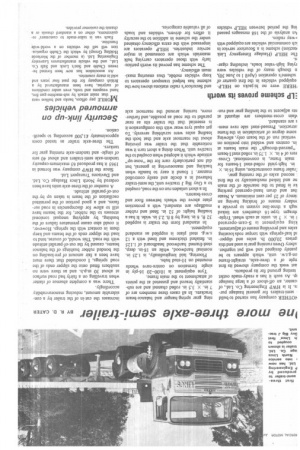Pne more three-axle semi-trailer BY R. D. CATER
Page 33

If you've noticed an error in this article please click here to report it so we can fix it.
slOTHER company has started to build semi-trailers for general haulage pur:s. It is HWP Engineering Co. Ltd., of !caster, an off-shoot of a large haulage ip. As such it has a ready-made outlet testing ground for its products.
ast week the company showed its first nple of a three-axle, straight-frame on-g.t.w. unit, which appears to be ivately designed and well put together. .ubery Owen running gear is used and this tprises 20,000 lb. axles and slipperxl leaf-springs with torque rods locating axles and providing means of adjustment. king equipment is S-cam-operated i in. x 7 in. units at each wheel. Triple)hragm type-16 chambers are linked nigh a three-line system to provide a mdary means of braking having an iency of 25 per cent minimum. A Neate het and drum hand-operated parking ke is fitted to the nearside of the main ne and linked mechanically to the first second axles of the running gear.
['railer frame construction, using 16 in. x in. high-yield rolled-steel I-beams for main frame, is conventional. Crossrers of 4 in. X 1.75 in. rolled steel I-beam "pierced-through" the main beams at in. centres and welded into position on vertical run of the beam only, allowing some degree of articulation in the frame tstruction. Pressed-steel side rave mems are standard.
vlain cross-members are situated at nts adjacent to the landing gear and run ning gear spring-hanger and balance-beam brackets. In all cases these members arc of 7 in. x 3.5 in. rolled channel and are substantially braced and gusseted at the points of attachment to the main frame.
Tyre equipment is 10.00-20 16-ply in single formation on centre-nave wheels mounted on 10-stud hubs.
Flooring, laid longitudinally, is 1.25 in. nominal hardwood, while an 18-in, deep, steel-framed hardwood headboard of 1.125 in. finished thickness and lined with a 12 s.w.g steel plate is supplied as standard equipment.
In standard form the trailer is supplied 32 ft. 6 in. long by 8 ft. 2.5 in. wide. It has a loading height of 52 in. Steel and rubber mudflaps are standard. with a protection plate above the wheels between floor and cross-bearers.
In a short unladen run on the road, coupled to a Guy Big J tractive unit; the semi-trailer behaved in a docile and easily controlled manner. I found it easy to handle when backing and manoeuvring in general, but did not particularly care for the "nose-up" attitude which it adopted when coupled to the tractive unit. When doing a short turn it was noticeable that the trailer was pivoting about the rearmost axle and that both the leading axles were scrubbing severely. To get equal tyre wear with this configuration it is essential that the trailer sits as near parallel to the road as possible, and furthermore, turning around the rearmost axle increases the cut-in of the trailer by a considerable amount, reducing manoeuvrability accordingly.
There was a complete absence of clatter when travelling on a fairly bad road surface at about 30 m.p.h. and as there were no snubbers fitted onto the slipper ends of the road springs, I concluded that there must have been a fair amount of pre-loading on the bonded rubber bushings of the balance beams, caused by the out-of-parallel attitude with the road. This would, of course, tend to load the slipper ends of the beams and keep them in contact with the springs. However, it could also cause premature failure of the bushing, by applying unequal torsional stresses to the rubber, for the beams have still to allow for discrepancies in road surfaces, and a good portion of the permitted oscillation of the beam is taken up by the out-of-parallel attitude.
A number of the three-axle units have been ordered by North Lines Haulage Co. Ltd. and Davisons Transport Ltd.
Since the HWP company was formed in 1965 it has produced 65 maximum-capacity tandem-axle semi-trailers and about 40 sets of singleand tandem-axle running gear for tankers.
The three-axle trailer as tested costs approximately £1,500 according to specification.
























































































































